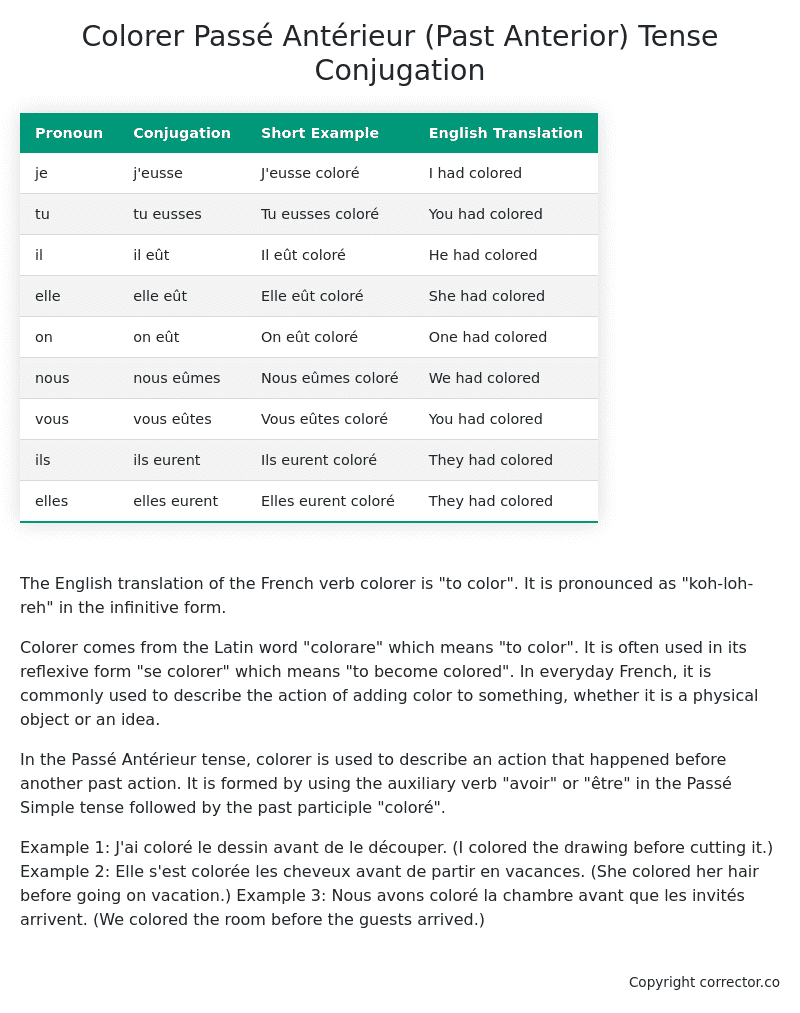Passé Antérieur (Past Anterior) Tense Conjugation of the French Verb colorer
Introduction to the verb colorer
The English translation of the French verb colorer is “to color”. It is pronounced as “koh-loh-reh” in the infinitive form.
Colorer comes from the Latin word “colorare” which means “to color”. It is often used in its reflexive form “se colorer” which means “to become colored”. In everyday French, it is commonly used to describe the action of adding color to something, whether it is a physical object or an idea.
In the Passé Antérieur tense, colorer is used to describe an action that happened before another past action. It is formed by using the auxiliary verb “avoir” or “être” in the Passé Simple tense followed by the past participle “coloré”.
Example 1: J’ai coloré le dessin avant de le découper. (I colored the drawing before cutting it.)
Example 2: Elle s’est colorée les cheveux avant de partir en vacances. (She colored her hair before going on vacation.)
Example 3: Nous avons coloré la chambre avant que les invités arrivent. (We colored the room before the guests arrived.)
Table of the Passé Antérieur (Past Anterior) Tense Conjugation of colorer
| Pronoun | Conjugation | Short Example | English Translation |
|---|---|---|---|
| je | j’eusse | J’eusse coloré | I had colored |
| tu | tu eusses | Tu eusses coloré | You had colored |
| il | il eût | Il eût coloré | He had colored |
| elle | elle eût | Elle eût coloré | She had colored |
| on | on eût | On eût coloré | One had colored |
| nous | nous eûmes | Nous eûmes coloré | We had colored |
| vous | vous eûtes | Vous eûtes coloré | You had colored |
| ils | ils eurent | Ils eurent coloré | They had colored |
| elles | elles eurent | Elles eurent coloré | They had colored |
Other Conjugations for Colorer.
Le Present (Present Tense) Conjugation of the French Verb colorer
Imparfait (Imperfect) Tense Conjugation of the French Verb colorer
Passé Simple (Simple Past) Tense Conjugation of the French Verb colorer
Passé Composé (Present Perfect) Tense Conjugation of the French Verb colorer
Futur Simple (Simple Future) Tense Conjugation of the French Verb colorer
Futur Proche (Near Future) Tense Conjugation of the French Verb colorer
Plus-que-parfait (Pluperfect) Tense Conjugation of the French Verb colorer
Passé Antérieur (Past Anterior) Tense Conjugation of the French Verb colorer (this article)
Futur Antérieur (Future Anterior) Tense Conjugation of the French Verb colorer
Subjonctif Présent (Subjunctive Present) Tense Conjugation of the French Verb colorer
Subjonctif Passé (Subjunctive Past) Tense Conjugation of the French Verb colorer
Subjonctif Imparfait (Subjunctive Imperfect) Tense Conjugation of the French Verb colorer
Subjonctif Plus-que-parfait (Subjunctive Pluperfect) Tense Conjugation of the French Verb colorer
Conditionnel Présent (Conditional Present) Tense Conjugation of the French Verb colorer
Conditionnel Passé (Conditional Past) Tense Conjugation of the French Verb colorer
L’impératif Présent (Imperative Present) Tense Conjugation of the French Verb colorer
L’infinitif Présent (Infinitive Present) Tense Conjugation of the French Verb colorer
Struggling with French verbs or the language in general? Why not use our free French Grammar Checker – no registration required!
Get a FREE Download Study Sheet of this Conjugation 🔥
Simply right click the image below, click “save image” and get your free reference for the colorer Passé Antérieur tense conjugation!

Colorer – About the French Passé Antérieur (Past Anterior) Tense
Formation of the Passé Antérieur
Common Usage Patterns
Literature
Historical Texts
Formal Writing
Interactions with Other Tenses
Passé Composé (Present Perfect)
Imparfait (Imperfect)
Futur Antérieur (Future Perfect)
Summary
I hope you enjoyed this article on the verb colorer. Still in a learning mood? Check out another TOTALLY random French verb conjugation!


